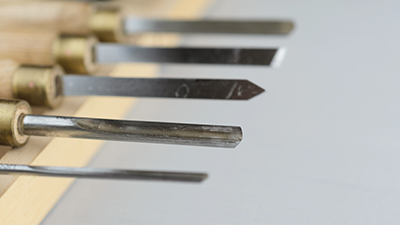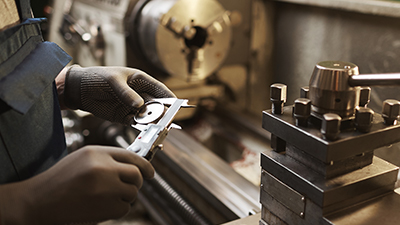Wood lathes and metal lathes share many common characteristics. The significant difference is the material that is used by the worker in the machine. Since the processes and the tools are similar, the question of whether you can turn wood on a metal lathe is legitimate.
Without a doubt, yes, you can do woodturning on a metal lathe. While there are differences between metal lathes and wood lathes, the concept is the same
If you have a metal lathe and need to do woodturning, nothing is stopping you. However, you will need to address some differences between a metal lathe and a wood lather. Protecting your lathe from wood shavings and sawdust is one consideration. Differences in the techniques between wood and metal are the others. We’ve compiled a guide to help you use your metal lathe to turn wood.
Wood vs. Metal – More Differences than Just the Material
There are some significant differences between wood lathes and metal lathes despite the appearance and the concept. All lathes, wood or metal, work by spinning the workpiece and using specialized tools to remove material from the workpiece. Beyond this basic concept held in common, there are significant differences in wood and metal lathes.
- Wood lathes are smaller and simpler than metal lathes
- Metal lathes are more powerful than wood lathes
- Woodturning is usually done by hand using special chisels
- Metal lathes used hardened steel cutting tools that are fixed to the lathe and manipulated mechanically.
- Metal lathes don’t have tool rests for hand turning
- Wood lathes usually turn faster than metal lathes
- Metal lathes use a direct drive system rather than belts and pulleys like a wood lathe
However, despite these differences, metal lathes are quite capable of turning wood. With some simple to add accessories and knowledge of the machines, using a metal lathe to make woodturning is possible.
Wood on a Metal Lathe– The Problems
Several factors need consideration when turning wood on a metal lathe.
- Cost factors
- Tools
- Setups
- Your Lathe
Understanding how these factors can affect the use of your metal lathe as a woodturning lathe may alter your decision.
Cost Factors – Is It Better to Purchase a Wood Lathe?
Metal lathes tend to be much more expensive than wood lathes. If your projects are mostly wood, it is probably a wiser decision to purchase a dedicated woodturning lathe than to invest in a metal lathe.
However, some shops are already equipped with a metal lathe but need to create turned wood products. A metal lathe is useable in this instance. The costs associated with using a metal lathe to turn wood include:
- The cost of adding a tool rest to the metal lathe
- Buying or creating the proper attachment points for your wood project
- Acquiring a set of woodturning tools
- Protecting your metal lathe from wood chips and sawdust
All these factors contribute to the extra cost associated with using your metal lathe to turn wood.

Special Woodturning Tools – The Right Equipment Makes A Difference
Very few machine shops have the proper tools for turning wood. If you need to produce turned wooden parts and use your metal lathe, you will need to buy a set of woodturning chisels. At the very least, you will need:
- Roughing Gouge
- Shallow Fluted Gouge
- Skew chisel
- Parting tool
These necessary woodturning tools will get you started using your metal lathe as a woodturning tool. If you intend to try and turn bowls or cups, you will need to add a few more chisels to your tool cabinet.
- Deep fluted or bowl gouge
- Back-ground bowl gouge
In a well-equipped metal shop, it may be possible for someone knowledgeable in metalworking to make perfectly useable woodturning chisels. Making your own could be a way to save money but remember to consider your time.
Setting Up on the Lathe for Wood – Special Accessories
Setting up your metal lathe to turn wood involves making some changes to the metal lather to accommodate the differences in the materials. The setup changes most metal lather operators make to turn wood are:
- Lathe speeds – Wood lathes usually turn much faster than metal lathes. You will want to set the speed on your metal lathe to its highest setting to get the best results with wood.
- Adding a tool rest – Woodturning is a handwork process. Metal lathes typically attach the cutting tool to the tool carrier on the lathe. The cutting tool moves using quite sensitive controls on the lather. Woodturning chisels rest in the woodworker’s hand. You must create a tool rest on your metal lathe.
- Headstock and tailstock spindles – Most metal lathes will not have the correct headstock and tailstock spindles to hold the wooden workpiece. You will need to either fabricate or purchase a headstock and tailstock that will mount to your metal lathe to hold the wood in place.
Protecting your Metal Lathe – Wood Can be a Problem
You may be surprised to learn that wood can be a major issue with your metal lathe’s moving parts. Wood contains silicates that can be highly abrasive. Having these silicates working against the metal parts of your lathe can seriously affect its accuracy.
Some woods also contains oils or resins that can build up on the moving parts of your metal lathe. These oils and resins can attract dust and other particles that affect your lathe’s accuracy.
It would be best if you considered protecting your metal lathe from wood chips and sawdust by draping its moving parts with plastic. A little preventive action is much better than spending hours disassembling your lathe to do a proper cleaning.
Thinking Creatively – Using the Metal Lathes Features for Wood Turning
Using a metal lathe for woodturning does offer some interesting possibilities. Metal lathes allow pattern making or the ability to reproduce parts with amazing accuracy. Once you establish a pattern, most metal lathes will accurately reproduce that pattern automatically.
You can use this capability to your advantage in woodturning. Nothing in the rule book says you must turn wood by hand. There are woodturning lathes that have this same capability to reproduce patterns. Using your metal lathe in the same way only requires a means to attach the wood chisel to the metal lathes tool post.
Accuracy Made Easy on a Metal Lathe
By and large, metal lathes are highly accurate machines. Most good metal lathes are accurate to a thousandth of an inch tolerance. You can use your metal lathes precision ability to create perfect columns. If you are a bowl turner, the accuracy of a metal lathe makes ultra-thin walls on your bowl a possibility.
Don’t discount the advantages that a metal lathe can provide, especially if you are doing woodturning that involves reproducing many parts or where accuracy is required. Metal lathes can offer you a degree of control that a standard woodturning lathe can’t match.
Mixing Wood and Metal – Step Outside the Box
If you have a metal lathe in your shop and woodturning is on your list of projects, you may already have the necessary tools and equipment. With a few extra accessories, you can begin to turn wood effectively and accurately with your metal lathe. A little ingenuity and persistence are all that is required.
We hope that this article has answered your questions about turning wood on a metal lathe. While the two arts, metal turning and woodturning, share many characteristics, the processes have some differences that need consideration.

